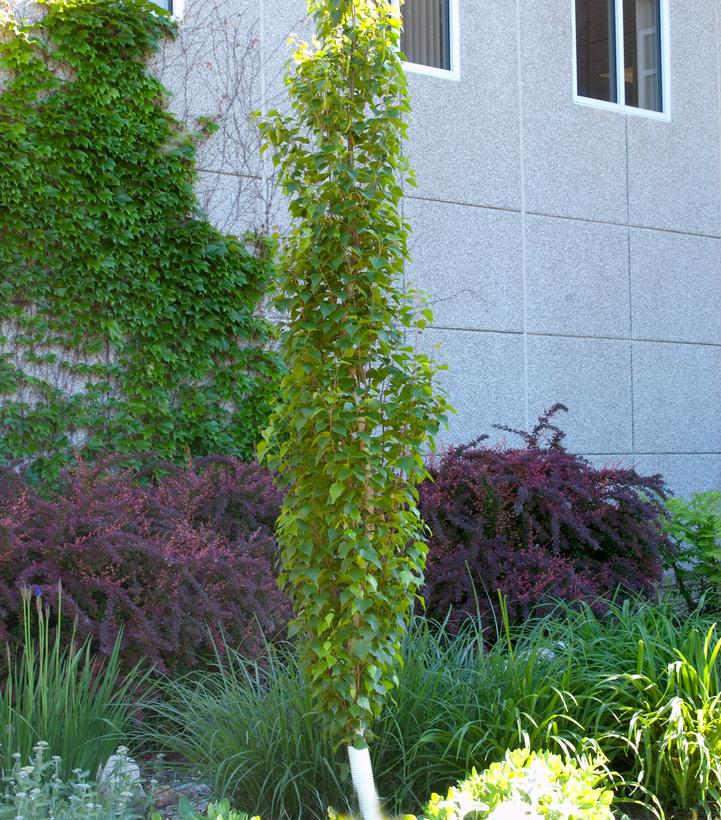If you’re seeking a stately, space-saving specimen for your landscape, look no further than Parkland Pillar® Birch. This columnar form of Asian white birch was selected for its remarkably narrow habit—reaching just 6–7 feet wide at maturity—paired with the lustrous white bark and golden fall color that make birches such prized garden accents. Whether used as a living screen, a vertical focal point, or a dramatic accent in a tight urban yard, Parkland Pillar® Birch brings year-round interest and effortless elegance to Southeast Wisconsin gardens.
Key Characteristics
-
Form & Size
-
Columnar, upright habit: 30–40 ft tall × 6–7 ft wide
-
Dense branching creates a clean, vertical silhouette
-
-
Bark & Foliage
-
Smooth, creamy-white bark that stands out against dark evergreens and masonry
-
Bright green, ovate leaves (2–3″ long) with serrated edges
-
-
Seasonal Interest
-
Spring/Summer: Fresh green canopy adds height and structure
-
Fall: Leaves turn a vibrant golden yellow, creating a glowing column
-
Winter: Bark shines against the snowy landscape, offering sculptural appeal
-
Cultural Requirements
-
Light:
-
Thrives in full sun to light shade; best bark color develops with ample sunlight.
-
-
Soil:
-
Prefers moist, well-drained loam but tolerates a range of soils, including clay and alkaline conditions.
-
Avoid prolonged waterlogged sites; good drainage is essential.
-
-
Water:
-
Provide regular moisture during establishment (first 1–2 years).
-
Once established, moderately drought-tolerant; supplemental watering during hot, dry spells will keep foliage lush.
-
-
Hardiness:
-
USDA Zones 3–7.
-
Resistant to cold winters and shows some tolerance to heat and alkaline soils.
-
-
Pest & Disease Resistance:
-
Exhibits improved resistance to bronze birch borer compared to other birch cultivars.
-
Minimal pruning required; remove any dead or crossing branches in late winter.
-
Landscape Uses & Companion Plants
-
Narrow Screening & Privacy
-
Ideal for lining driveways, property lines, or tight urban lots where space is limited.
-
Plant 4–6 feet apart for a living privacy screen.
-
-
Vertical Accents & Specimens
-
Use one or three specimens as a dramatic focal point in a courtyard or small lawn.
-
Pair with contrasting textures—such as blue spruce or dark-leaf hostas—to highlight its columnar form and bark.
-
-
Mixed Borders & Foundation Plantings
-
Mix with low-growing evergreens (e.g., dwarf yews) and spring bulbs for layered seasonal interest.
-
Underplant with shade-tolerant perennials like Heuchera and Ferns to soften the base.
-
-
Container Planting
-
Young specimens can thrive in large planters on patios—just ensure adequate root space and moisture.
-
Combine with ornamental grasses or dwarf perennials for a textural container display.
-
Seasonal Care & Maintenance
-
Planting Tips
-
Dig a hole twice as wide as the root ball but no deeper than its height.
-
Backfill with native soil amended with compost; water thoroughly.
-
-
Pruning
-
Minimal pruning needed. Remove deadwood and upright competing leaders in late winter before bud break.
-
Maintain single-stemmed form by removing lower suckers and side shoots from the trunk.
-
-
Mulching & Fertilization
-
Apply a 2–3 inch layer of organic mulch around the drip line—keep mulch away from the trunk to prevent rot.
-
Fertilize with a balanced slow-release tree fertilizer in early spring.
-
-
Winter Care
-
Young trees benefit from a temporary windbreak or burlap wrap in the first winter to protect bark from sunscald.
-
After establishment, bark withstands sun and cold without damage.
-
Why We Love Parkland Pillar® Birch
-
Space-Saving Elegance: Offers all the charm of white birch in a narrow footprint ideal for modern landscapes.
-
Four-Season Appeal: Striking bark, lush foliage, vibrant fall color, and winter form make it a year-round standout.
-
Low-Maintenance Performance: Resistant to common birch pests and diseases, with minimal pruning requirements.
Conclusion & Availability
Parkland Pillar® Birch (Betula platyphylla ‘Jefpark’) is the perfect solution when you crave the grace of a white birch but have limited horizontal space. Its slender profile, radiant fall color, and commanding winter silhouette bring elegance and structure to any Southeast Wisconsin garden. Check it out here!

